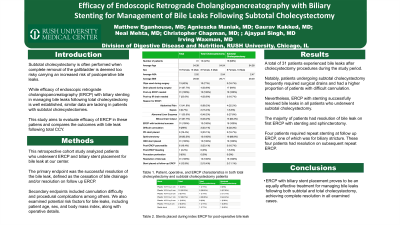Tuesday Poster Session
Category: Biliary/Pancreas
P3482 - Efficacy of Endoscopic Retrograde Cholangiopancreatography With Biliary Stenting for Management of Bile Leaks Following Subtotal Cholecystectomy
Tuesday, October 29, 2024
10:30 AM - 4:00 PM ET
Location: Exhibit Hall E

Has Audio

Matthew M. Eganhouse, MD
Rush University Medical Center
Chicago, IL
Presenting Author(s)
Matthew M. Eganhouse, MD, Agnieska Maniak, MD, Gauarav Kakked, MD, Neal A. Mehta, MD, Christopher Chapman, MD, Ajaypal Singh, MD, Irving Waxman, MD
Rush University Medical Center, Chicago, IL
Introduction: Subtotal cholecystectomy is often performed when complete removal of the gallbladder is deemed too risky. Although effective, this procedure carries an increased risk of postoperative bile leaks, which can lead to significant morbidity and extended hospital stays. This study assesses the effectiveness of endoscopic retrograde cholangiopancreatography (ERCP) with biliary stenting in managing bile leaks following both total and subtotal cholecystectomies, aims to identify risk factors for these leaks, and compares the outcomes between the two surgical techniques.
Methods: This retrospective cohort study analyzed patients who underwent either total or subtotal cholecystectomy at our institution from January 2022 to June 2024. The cohort included patients who developed postoperative bile leaks and were treated with ERCP and biliary stent placement. We collected data on demographics, comorbidities, surgical and ERCP specifics, stent details, and clinical outcomes. The primary endpoint was the successful resolution of the bile leak, defined as the cessation of bile drainage and/or resolution on follow up ERCP. Secondary endpoints included details of the ERCP procedure, such as cannulation difficulty, stent type, and procedural complications. We also examined potential risk factors for bile leaks, including patient age, sex, and body mass index, along with operative details.
Results: A total of 31 patients experienced bile leaks after cholecystectomy procedures during the study period. The average age was 54 years. Notably, patients undergoing subtotal cholecystectomy frequently required surgical drains and had a higher proportion of patients needing double wire technique. Nevertheless, ERCP with stenting successfully resolved bile leaks in all patients who underwent subtotal cholecystectomy. The majority of patients had resolution of bile leak on first ERCP with stenting and sphincterotomy. Four patients required repeat stenting at follow up ERCP, one of which was for biliary stricture. These four patients had resolution on subsequent repeat ERCP. Most of the stents placed were 10 Fr plastic stents for both the subtotal and total cholecystectomy groups.
Discussion: ERCP with biliary stent placement proves to be a highly effective treatment for managing bile leaks following both subtotal and total cholecystectomy, achieving complete resolution in all examined cases.
Note: The table for this abstract can be viewed in the ePoster Gallery section of the ACG 2024 ePoster Site or in The American Journal of Gastroenterology's abstract supplement issue, both of which will be available starting October 27, 2024.
Disclosures:
Matthew M. Eganhouse, MD, Agnieska Maniak, MD, Gauarav Kakked, MD, Neal A. Mehta, MD, Christopher Chapman, MD, Ajaypal Singh, MD, Irving Waxman, MD. P3482 - Efficacy of Endoscopic Retrograde Cholangiopancreatography With Biliary Stenting for Management of Bile Leaks Following Subtotal Cholecystectomy, ACG 2024 Annual Scientific Meeting Abstracts. Philadelphia, PA: American College of Gastroenterology.
Rush University Medical Center, Chicago, IL
Introduction: Subtotal cholecystectomy is often performed when complete removal of the gallbladder is deemed too risky. Although effective, this procedure carries an increased risk of postoperative bile leaks, which can lead to significant morbidity and extended hospital stays. This study assesses the effectiveness of endoscopic retrograde cholangiopancreatography (ERCP) with biliary stenting in managing bile leaks following both total and subtotal cholecystectomies, aims to identify risk factors for these leaks, and compares the outcomes between the two surgical techniques.
Methods: This retrospective cohort study analyzed patients who underwent either total or subtotal cholecystectomy at our institution from January 2022 to June 2024. The cohort included patients who developed postoperative bile leaks and were treated with ERCP and biliary stent placement. We collected data on demographics, comorbidities, surgical and ERCP specifics, stent details, and clinical outcomes. The primary endpoint was the successful resolution of the bile leak, defined as the cessation of bile drainage and/or resolution on follow up ERCP. Secondary endpoints included details of the ERCP procedure, such as cannulation difficulty, stent type, and procedural complications. We also examined potential risk factors for bile leaks, including patient age, sex, and body mass index, along with operative details.
Results: A total of 31 patients experienced bile leaks after cholecystectomy procedures during the study period. The average age was 54 years. Notably, patients undergoing subtotal cholecystectomy frequently required surgical drains and had a higher proportion of patients needing double wire technique. Nevertheless, ERCP with stenting successfully resolved bile leaks in all patients who underwent subtotal cholecystectomy. The majority of patients had resolution of bile leak on first ERCP with stenting and sphincterotomy. Four patients required repeat stenting at follow up ERCP, one of which was for biliary stricture. These four patients had resolution on subsequent repeat ERCP. Most of the stents placed were 10 Fr plastic stents for both the subtotal and total cholecystectomy groups.
Discussion: ERCP with biliary stent placement proves to be a highly effective treatment for managing bile leaks following both subtotal and total cholecystectomy, achieving complete resolution in all examined cases.
Note: The table for this abstract can be viewed in the ePoster Gallery section of the ACG 2024 ePoster Site or in The American Journal of Gastroenterology's abstract supplement issue, both of which will be available starting October 27, 2024.
Disclosures:
Matthew Eganhouse indicated no relevant financial relationships.
Agnieska Maniak indicated no relevant financial relationships.
Gauarav Kakked indicated no relevant financial relationships.
Neal Mehta: Boston Scientific – Consultant. Castle Biosciences – Consultant. Conmed – Consultant. Medtronic – Consultant.
Christopher Chapman: Apollo Endosurgery – Consultant. Boston Scientific – Consultant. Olympus – Consultant.
Ajaypal Singh indicated no relevant financial relationships.
Irving Waxman indicated no relevant financial relationships.
Matthew M. Eganhouse, MD, Agnieska Maniak, MD, Gauarav Kakked, MD, Neal A. Mehta, MD, Christopher Chapman, MD, Ajaypal Singh, MD, Irving Waxman, MD. P3482 - Efficacy of Endoscopic Retrograde Cholangiopancreatography With Biliary Stenting for Management of Bile Leaks Following Subtotal Cholecystectomy, ACG 2024 Annual Scientific Meeting Abstracts. Philadelphia, PA: American College of Gastroenterology.
